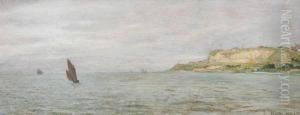Regnier Paintings
Nicolas Régnier, born in 1590 in Maubeuge, France, was a notable figure in the Baroque art movement, known for his skill as a painter, art collector, and dealer. His work is characterized by its dramatic use of light and shadow, a hallmark of the Baroque style, and his subjects often included religious themes, portraits, and scenes from mythology. Régnier's journey as an artist took him across Europe, with significant periods in Italy, which profoundly influenced his style and technique.
After training in his native France, Régnier moved to Italy in his early twenties, like many artists of his time seeking to study the works of the Renaissance masters and the emerging Baroque style. He spent most of his career in Venice and Rome, cities that were vibrant centers for artists during the 17th century. In Rome, Régnier became associated with the followers of Caravaggio, adopting the master's dramatic chiaroscuro and realistic depiction of figures. His works from this period show a keen interest in human emotion and narrative, qualities that made Caravaggio's style revolutionary.
Régnier's reputation grew, and he became known not just for his artistic talents but also for his acumen as an art dealer and collector, navigating the complex network of patrons, artists, and collectors that defined the 17th-century art world. This role significantly influenced his artistic output, as he often painted with an eye toward the tastes and preferences of his clients and the market.
In Venice, Régnier's style evolved, showing the influence of the Venetian colorists, with a softer palette and a greater emphasis on atmosphere. His work from this period includes some of his most celebrated paintings, which exhibit a masterful balance of realism and idealization. Régnier's influence extended beyond his lifetime, as his paintings were collected and studied by artists and connoisseurs. Despite the high regard in which he was held during his lifetime, Régnier's name became somewhat obscured over the centuries, overshadowed by his more famous contemporaries. However, recent scholarship has begun to reassess his contribution to Baroque art, recognizing the sophistication of his technique and the depth of his understanding of human psychology.
Nicolas Régnier's death in 1667 marked the end of a prolific career that spanned several decades and countries. His legacy, encapsulated in the canvases that hang in museums and private collections around the world, continues to offer insight into the richness and complexity of Baroque art. Régnier's life and work embody the spirit of an era characterized by dramatic expression, exploration of light and shadow, and a deep engagement with the human experience.
